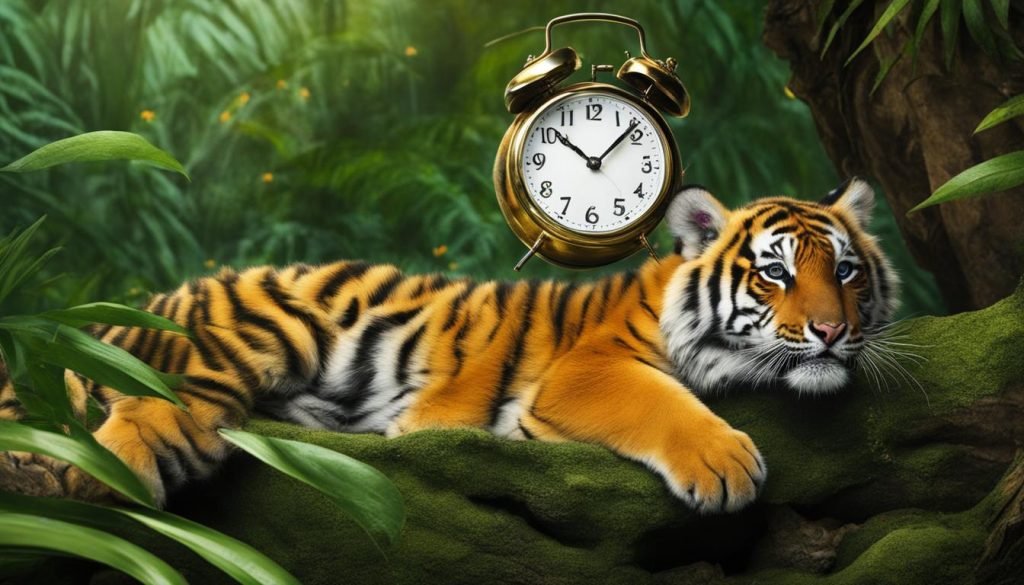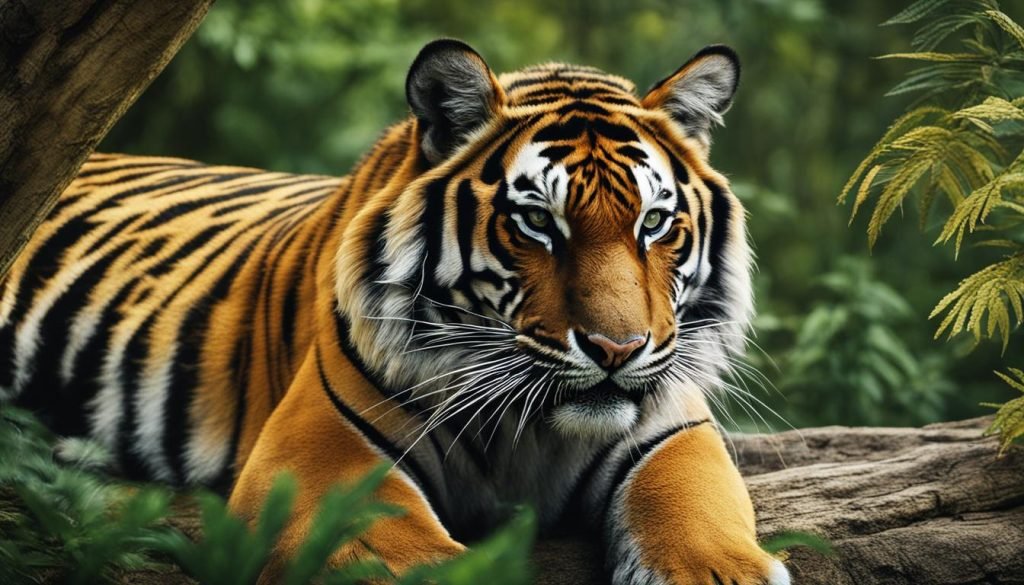How Long Do Tigers Live? Exploring Lifespans
In the animal kingdom, tigers hold a prominent place, renowned for their imposing size and striking beauty. However, how long do tigers live? Their lifespan is one of the most intriguing aspects of this majestic creature. In this comprehensive guide, we will explore the average lifespan of tigers, their survival rate, and the factors that influence their longevity.
The lifespan of tigers varies depending on numerous factors such as habitat, genetic disposition, food availability, and human activities. Our exploration will consider these aspects, discuss the differences between the survival rates of wild and captive tigers, examine the lifespan variations among different tiger species, and detail longevity strategies in tiger conservation.
Key Takeaways
- Tigers are renowned for their size and beauty, but their lifespan remains one of the most intriguing aspects of this majestic creature.
- Factors that influence the lifespan of tigers include habitat conditions, food availability, genetic factors, and human activities.
- Tigers in captivity experience a different set of conditions compared to those in the wild.
- Conservation efforts aim to ensure the long-term survival of tigers and include habitat preservation, anti-poaching measures, and initiatives aimed at minimizing human-wildlife conflict.
- Understanding the lifespan of tigers is crucial in developing measures to protect and conserve this magnificent species.
Tiger Quiz
How well do you know tigers? Test your knowledge below!

How Long Do Tigers Live: The Lifespan of Tigers

The lifespan of tigers, one of the most iconic big cats, has been a subject of study for many years. By examining the average lifespan of tigers, we can understand how long they live and the factors that impact their survival rates.
According to research, the average lifespan of tigers is around 10 to 12 years in the wild, while those living in captivity can live up to 20 years or more.
Several studies have been conducted to determine the average lifespan of tigers in the wild. These studies have revealed that factors such as habitat conditions, food availability, natural predators, and human activities play a significant role in influencing the lifespan of tigers.
For example, tigers living in areas with low prey density or high human disturbance tend to have a shorter lifespan compared to those living in areas with stable prey populations and minimal human interaction.
Tiger Lifespan Studies
One of the most comprehensive studies conducted on tiger lifespan was carried out by the Wildlife Conservation Society (WCS) in collaboration with the Indian government. According to this study, the average lifespan of wild tigers in India was found to be around 10 years, with females living slightly longer than males. This study also revealed that tigers living in protected reserves had a longer lifespan compared to those living in unprotected areas.
Another study conducted in the Russian Far East revealed that Siberian tigers living in protected areas had a lifespan of around 16 years, while those living outside protected areas had a lifespan of around 8 years. This study highlighted the importance of habitat protection in ensuring the longevity of tiger populations in the wild.
“Several studies have been conducted to determine the average lifespan of tigers in the wild. These studies have revealed that factors such as habitat conditions, food availability, natural predators, and human activities play a significant role in influencing the lifespan of tigers.”
While information on the lifespan of tigers in the wild is essential, it is equally important to examine the lifespan of tigers living in captivity. Tigers living in zoos or other captive environments can live longer than their counterparts in the wild due to better nutrition, medical care, and protection from predators. Therefore, studying the lifespan of tigers in captivity can provide valuable insights into the needs and requirements of these animals.
Factors Affecting Tiger Lifespan

The lifespan of tigers can be influenced by various factors. These range from genetic predispositions to environmental conditions and human activities. In the wild, tigers face challenges that can impact their survival rates, while those living in captivity experience a different set of conditions. It is essential to examine these factors to understand the lifespan variations among tigers.
Environmental Factors
The habitat in which tigers live plays a major role in their survival rates. Tigers residing in areas with ample prey, freshwater sources, and minimal human activity have a higher chance of survival. In contrast, those living in areas with limited resources or habitat destruction experience a decrease in their lifespan. Human activity, including deforestation, poaching, and human-wildlife conflict, also complicates the survival of tigers in the wild.
In captivity, tigers receive a different set of environmental conditions. They are protected from natural predators and have access to a consistent supply of food and water. However, living in an enclosed environment can also lead to various health issues such as obesity and stress.
Genetic Factors
Genetic factors also contribute to the lifespan of tigers. Tigers with genetic disorders have a lower chance of survival. Research has shown that Siberian tigers have a lower genetic variability than other subspecies, making them more prone to infection and hereditary diseases.
Lifespan Comparisons
| Tigers in the Wild | Tigers in Captivity |
|---|---|
| The average lifespan of tigers in the wild ranges from 10 to 15 years. | Tigers in captivity have an average lifespan of 16 to 18 years. |
| Tigers face various challenges in the wild, including habitat destruction, poaching, and natural predators. | Tigers in captivity are protected from natural predators but may face health issues due to stress and a lack of physical activity. |
Comparing the lifespan of tigers in the wild and in captivity showcases the impact of environmental conditions on tiger survival rates. While tigers in captivity have access to a consistent supply of food and water, they may experience health issues due to living in a confined space. Tigers in the wild face various challenges, and their lifespan is influenced by environmental conditions and human activities.
By examining the various factors that affect tiger lifespan, we can contribute to conservation efforts to ensure the long-term survival of tigers in the wild. Understanding the impact of both natural and human-caused threats on their lifespan can lead to strategies to preserve their populations and habitats.
Lifespan Variations Among Tiger Species

Different tiger species have variations in their lifespans. The Bengal tiger and Siberian tiger are two prominent tiger species that have distinct differences in their lifespan.
Bengal Tigers
Bengal tigers are found primarily in India and Bangladesh. They are known for their bright orange coats with black stripes and are the most common tiger species in the world.
According to research, the average lifespan of the Bengal tiger is around 8-10 years in the wild. The lifespan of Bengal tigers can be affected by various factors, such as habitat loss, prey depletion, and human-wildlife conflicts.
Bengal tigers are also prone to genetic disorders such as dwarfism and albinism, which can affect their chances of survival and compromise their health.
Siberian Tigers
Siberian tigers are the largest tiger species, with males weighing up to 660 pounds and females up to 400 pounds. They are found primarily in Russia and northeastern China.
Siberian tigers are classified as endangered, with an estimated population of around 500 in the wild.
In the wild, the average lifespan of Siberian tigers is around 10-15 years. However, in captivity, they can live up to 20 years or more.
The lifespan of Siberian tigers can be influenced by factors such as habitat loss, poaching, and loss of prey species.
“It is not just a matter of saving a few endangered species; if we let the tiger go, we’ll lose much more than just a big cat. If tigers disappear, it will cause a cascading effect on the entire ecosystem that humans depend on for vital ecological services.” – Alan Rabinowitz
By understanding the lifespan variations between different tiger species, we can gain insights into the factors that influence their longevity and work towards ensuring their survival.
Comparing Captive and Wild Tiger Lifespans
Tigers living in captivity are exposed to a different set of environmental and demographic factors compared to their wild counterparts, which can ultimately affect their lifespan. Although it is difficult to compare the lifespan of captive and wild tigers due to differences in habitats, food availability, and human interference, studies have shown that tigers in captivity can live longer than those in the wild.
In the wild, tigers face several challenges, including competition for food and habitat, natural predators, and human activities such as poaching and habitat destruction. These factors decrease the lifespan of wild tigers considerably, with some tigers not making it past their first year.
On the other hand, tigers living in captivity have access to a constant supply of food and medical care, reducing the risk of malnutrition and disease. Captive tigers also have lower rates of predation and human interference, which can contribute to their longer lifespan. In some cases, captive tigers can live up to 20 years or more.
It is important to note, however, that captive tigers can face unique health challenges due to the lack of physical activity and the stress of confinement. Some captive tigers also experience genetic and behavioral issues due to inbreeding, which can compromise their health and lifespan.
In summary, the lifespan of tigers can differ significantly between those living in the wild and those in captivity. While captive tigers generally have a longer lifespan due to access to medical care and an abundance of food, they can face unique health challenges that affect their lifespan.
As such, it is crucial to promote efforts that aim at conserving tiger populations in the wild and to ensure that captive tigers receive proper care to increase their longevity and overall well-being.
Longevity Strategies in Tiger Conservation

To ensure the survival of tigers and increase their lifespan, conservation efforts play a crucial role. Here are some of the strategies implemented by conservationists:
- Habitat preservation: Protecting the natural habitats where tigers live is important to ensure their survival. This involves protecting forests from deforestation, fragmentation, and degradation caused by human activities.
- Anti-poaching measures: Poaching remains the main threat to tiger conservation, and anti-poaching measures play a crucial role in protecting tigers from illegal hunting. This involves implementing laws and regulations, increasing law enforcement, and reducing demand for tiger products.
- Minimizing human-wildlife conflict: Human-tiger conflict is a major challenge for tiger conservation, and minimizing conflict is essential to reduce the number of tigers killed or injured by humans. This involves developing strategies to prevent tiger attacks on humans and livestock, while also providing compensation to affected communities to reduce conflicts.
By implementing these strategies, conservationists hope to increase the average lifespan of tigers and their life expectancy.
“Conservation is a state of harmony between men and land.” – Aldo Leopold
Conclusion
After exploring the lifespan of tigers, we have gained a deeper understanding of the factors that influence their survival. The average lifespan of tigers in the wild is around 10-15 years, while those living in captivity may live up to 20 years.
Their survival rate is influenced by a variety of factors such as habitat conditions, food availability, natural predators, and human activities. However, conservation efforts aimed at habitat preservation, anti-poaching measures, and minimizing human-wildlife conflict can contribute to increasing their lifespan and overall longevity.
Tigers play a crucial role in maintaining ecological balance, and it is essential to work towards their conservation and protection. By understanding the importance of these majestic creatures, we can ensure their long-term survival.
So, How Long Do Tigers Live? The answer is dependent on numerous factors, but with proper conservation measures, we can help to extend their lifespan, allowing these iconic animals to continue reigning over their habitats.







